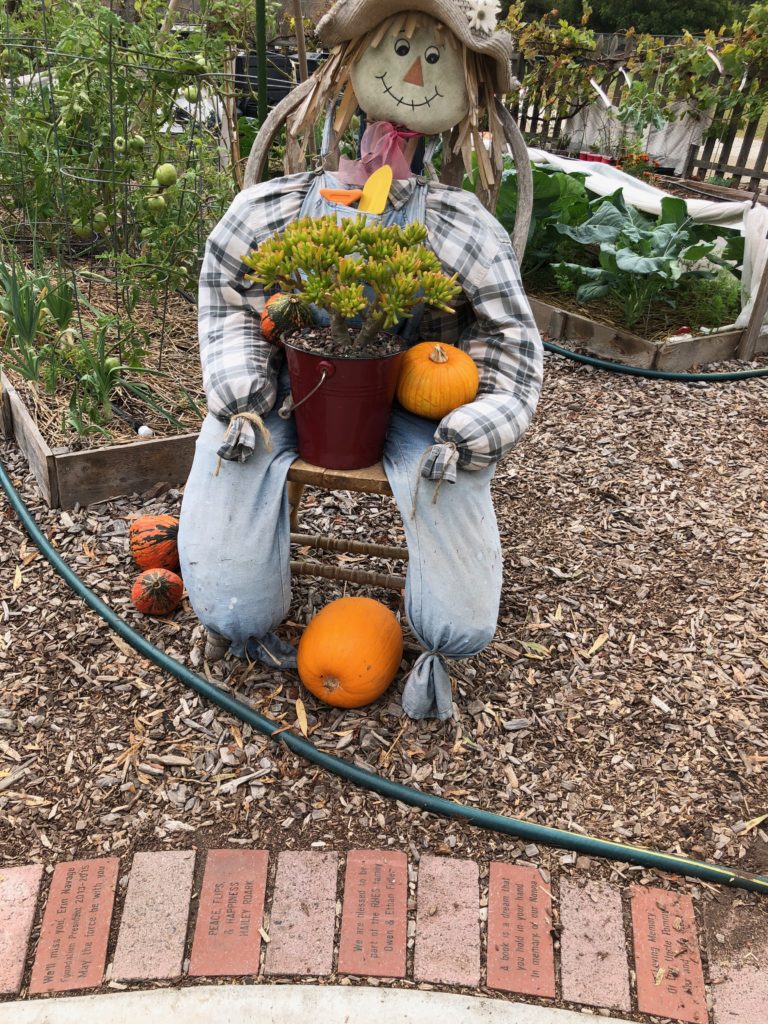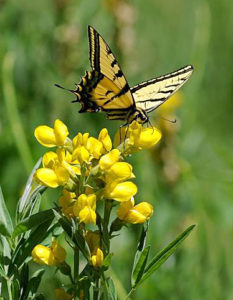Science is easily linked to the school garden and schoolyard habitat. The garden can support science fair projects and provide hands on experiences for content instruction. Literacy requirements for Common Core include reading non-fiction and garden related books that supply a rich source of scientific information.
The garden is a focus for teaching concepts of classification, plant physiology and reproduction, ecology, plant and animal interaction, animal behavior, weather, climate change, health, and nutrition. In addition to the content from books and other media, students at all grade levels can use the garden laboratory for science activities.
Preschoolers and primary grade learners are naturally curious and want to investigate their surroundings. The garden provides an ideal environment for encouraging and supporting their observation, discovery, and information gathering behaviors. Younger students may:
-
- Germinate bean seeds in plastic baggies or jars.
- Sprout a carrot top, a celery bottom, or plant a pineapple top.
- Dissect flowers to learn about the parts and their functions.
- Discuss daily nutritional needs emphasizing fruits and vegetables.
Using observational skills, all grades might learn animal behavior from those they find in the garden. Garden related activities include:
-
- Making a toad house and learning about amphibians.
- Making a scarecrow and observing the birds’ reactions over time.
- Identifying and observing insects.
- Sorting insects into categories (e.g., beneficials and pests).
- Building a praying mantis house and then studying and recording their habits.
- Studying local birds and building birdhouses or feeders.
- Studying worms, building a worm bin, and harvesting the castings and tea.

Using the Garden for Experiments
The garden provides a perfect setting for gathering and analyzing data, experimenting and evaluating results. All NGSS Science and Engineering practices are well suited for garden lessons.
NGSS Science and Engineering Practices (K-8)
-
- Asking questions and defining problems
- Developing and using models
- Planning and carrying out investigations
- Analyzing and interpreting data
- Using mathematics and computational thinking
- Constructing explanations and designing solutions
- Engaging in argument from evidence
- Obtaining, evaluating, and communicating information
Students might:
-
- Record growth rates of plants receiving different watering frequencies or amounts.
- Test the effects of using mulch versus no mulch.
- Observe changes in the growth rate of plants in response to varying sun exposures.
- Compare the benefits, growth rate, or vigor of plants started from seed vs. those planted from transplants.
- Record plant growth rate and vigor using no fertilizer, chemical fertilizer or organic fertilizers.
- Compare plant responses to varying strengths of fertilizer or time of application.
- Grow plants in different mediums such as soil, sand, water, a variety of potting soils, etc.
- Test organic pest controls identifying and counting insects, etc. before and after use.
- Test the vigor of plants by removing weeds versus leaving weeds among the test plants.
- Change the environment in a creative, experimental way such as growing half the plants upside down.
- Treat seeds differently prior to planting to see which germinate fastest.
- Determine which plants can be grown hydroponically.
- Use the garden to conduct erosion tests, measure run-off, determine best watering method, etc.

Students Observing Worms
Students at all grade levels can use the Scientific Method to perform experiments in the garden laboratory.
Preschool Investigation
Teachers can encourage a sense of wonder and capitalize on their preschoolers’ natural curiosity by leading students to:
-
-
-
- Guess “what if” you changed something plants need.
- Test their ideas.
- Share what happened by telling about their experiment or drawing a picture.
-
-
Primary Grades Observation and Experimentation
The garden environment offers students an opportunity to:
-
-
-
- Make and record observations.
- Ask questions, “What if…”.
- Make a guess as to what will happen.
- Test ideas, changing only one thing.
- Record data in a journal, on a chart, or with a camera.
- Share their findings.
-
-

Intermediate, Middle and High School Experimentation
The garden environment offers students an opportunity to:
-
-
-
- Observe and/or research for evidence and information.
- Form a hypothesis.
- Design an experiment to test a hypothesis.
- List materials needed.
- List steps for method, testing only one variable at a time, and using controls.
- Record the data.
- Show the data on a graph.
- Analyze the data and interpret the results.
- Make comparisons with other similar experiments.
- Suggest further experiments and applications.
-
-
Lessons and Units
The activities provided in this guide represent only a few ways the garden can be incorporated into your class. Some complete lessons and units for each grade level are available in the Curriculum section of the School Gardens website.
San Diego County Office of Education Environmental Literacy Section provides links to local environmental phenomena resources and NGSS aligned lessons.
Life Lab provides links to Next Generation Science Standards Performance Expectations by Grade Level for garden-based learning.
Next Generation Science Standards (NGSS) Performance Expectations
Key to codes:
Grade – LS (Life Sciences), ESS (Earth and Space Sciences), PS (Physical Sciences) –Standard Number
For Grades K-2:
K-LS1-1 Use observations to describe patterns of what plants and animals (including humans) need to survive.
K-ESS2-1 Use and share observations of local weather conditions to describe patterns over time.
K-ESS2-2 Construct an argument supported by evidence for how plants and animals (including humans) can change the environment to meet their needs.
K-ESS3-1 Use a model to represent the relationship between the needs of different plants, of animals (including humans), and the places they live.
K-ESS3-3 Communicate solutions that will reduce the impact of humans on the land, water, air, and/or other living things in the local environment.
1-LS1-1 Use materials to design a solution to a human problem by mimicking how plants and/or animals use their external parts to help them survive, grow, and meet their needs.
2-PS1-1 Plan and conduct an investigation to describe and classify different kinds of materials by their observable properties.
2-LS2-1 Plan and conduct an investigation to determine if plants need sunlight and water to grow.
2-LS2-2 Develop a simple model that mimics the function of an animal in dispersing seeds or pollinating plants.
2-LS4-1 Make observations of plants and animals to compare the diversity of life in different habitats.
2-ESS2-1 Compare multiple solutions designed to slow or prevent wind or water from changing the shape of the land.
For Grades 3-5:
3-LS1-1 Develop models to describe that organisms have unique and diverse life cycles but all have in common birth, growth, reproduction, and death.
3-LS3-1 Analyze and interpret data provide evidence that plants and animals have traits inherited from parents and that variation of these traits exists in a group of similar organisms.
3-LS3-2 Use evidence to support the explanation that traits can be influenced by the environment.
3-LS4-2 Use evidence to construct an explanation for how the variations in characteristics among individuals of the same species may provide advantages in surviving, finding mates, and reproducing.
3-LS4-3 Construct an argument with evidence that in a particular habitat some organisms can survive well, some survive less well, and some cannot survive at all.
4-LS1-1 Construct an argument that plants and animals have internal and external structures that function to support survival, growth, behavior, and reproduction.
5-PS3-1 Use models to describe that energy in animals; food (used for body repair, growth, motion, and to maintain body warmth) was once energy from the sun.
5-LS1-1 Support an argument that plants get the materials they need for growth chiefly from air and water.
5-LS2-1 Develop a model to describe the movement of matter among plants, animals, decomposers, and the environment.
5-ESS3-1 Obtain and combine information about ways individual communities use science ideas to protect the Earth’s resources and environment.
For Middle School:
MS-PS1-3 Gather and make sense of information to describe that synthetic materials come from natural resources and impact society.
MS-PS3-3 Apply scientific principles to design, construct, and test a device that either minimizes or maximizes thermal energy transfer.
MS-LS1-4 Use argument based on empirical evidence and scientific reasoning to support an explanation for how characteristic animal behaviors and specialized plant structures affect the probability of successful reproduction of animals and plants respectively.
MS-LS1-5 Construct a scientific explanation based on evidence for how environmental and genetic factors influence the growth of organisms.
MS-LS1-6 Construct a scientific explanation based on evidence for the role of photosynthesis in the cycling of matter and flow of energy into and out of organisms.
MS-LS1-7 Develop a model to describe how food is rearranged through chemical reactions forming new molecules that support growth and/or release energy as this matter moves through an organism.
MS-LS2-1 Analyze and interpret data to provide evidence for the effects of resource availability on organisms and populations of organisms in an ecosystem.
MS-LS2-2 Construct an explanation that predicts patterns of interactions among organisms across multiple ecosystems.
MS-LS2-3 Develop a model to describe the cycling of matter and flow of energy among living and nonliving parts of an ecosystem.
MS-LS2-4 Construct an argument supported by empirical evidence that changes to physical or biological components of an ecosystem affect populations.
MS-LS2-5 Evaluate competing design solutions for maintaining biodiversity and ecosystem services.
MS-LS3-2 Develop and use a model to describe why asexual reproduction results in offspring with identical genetic information and sexual reproduction results in offspring with genetic variation.
MS-LS4-5 Gather and synthesize information about the technologies that have changed.
MS-ESS2-1 Develop a model to describe the cycling of Earth’s materials and the flow of energy that drives this process.
MS-ESS2-4 Develop a model to describe the cycling of water through Earth’s systems driven by energy from the sun and the force of gravity.
MS-ESS3-3 Apply scientific principles to design a method for monitoring and minimizing a human impact on the environment.
List created by Life Lab.
Array